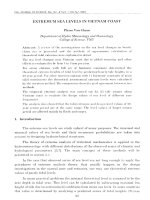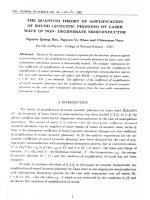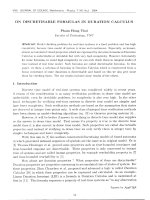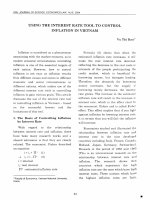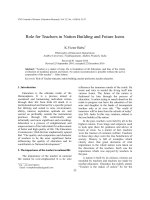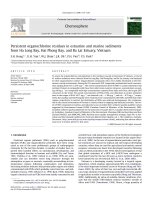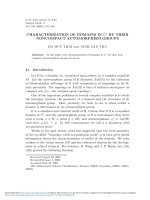DSpace at VNU: Drug addiction stigma in relation to methadone maintenance treatment by different service delivery models in Vietnam 7.Nguyen Hoang Long
Bạn đang xem bản rút gọn của tài liệu. Xem và tải ngay bản đầy đủ của tài liệu tại đây (388.67 KB, 9 trang )
Tran et al. BMC Public Health (2016):38
DOI 10.1186/s12889-016-2897-0
RESEARCH ARTICLE
Open Access
Drug addiction stigma in relation to
methadone maintenance treatment by
different service delivery models in
Vietnam
Bach Xuan Tran1,2* , Phuong Bich Vu1, Long Hoang Nguyen1,3, Sophia Knowlton Latkin4, Cuong Tat Nguyen5,
Huong Thu Thi Phan6 and Carl A. Latkin2
Abstract
Background: The rapid expansion of methadone maintenance treatment (MMT) services has significantly improved
health status and quality of life of patients. However, little is known about its impacts on addiction-related stigma
and associated factors.
Methods: A cross-sectional survey was conducted in 2013 in Vietnam’s capital, Hanoi, and Nam Dinh province
among 1016 methadone maintenance patients; 26.6 % at provincial AIDS centers (PAC) and 73.4 % at district health
centers (DHC), respectively. Drug addiction history and related stigma, health status, MMT-related covariates, and
sociodemographic characteristics were interviewed.
Results: More than one-sixth of the sample reported experiencing felt or enacted stigma, including Blame or
Judgement (17.2 %), Shame (19.9 %), or Others’ fear of HIV transmission (17.1 %). These proportions were higher in
PACs than in DHCs, which are integrated with other HIV or general health care services. Very few patients reported
being discriminated at the workplace (2.5 %) or at health care services (1.7 %); however, 15.6 % of patients at
PACs and 10.6 % of patients at DHCs reported discrimination in their communities. Drug users taking MMT for
longer periods were less likely to report felt stigma. Other factors associated with stigma against MMT patients
included the lack of comprehensive services, higher education, presence of pain/discomfort, and anxiety/
depression, self-reported HIV positive, and number of previous drug rehabilitation episodes.
Conclusion: The study shows a high level of stigma against MMT patients and emphasizes the necessity to
integrate MMT with comprehensive health and support services. Mass communication campaigns to reduce
stigma against people with drug addiction and HIV/AIDS, as well as vocational trainings and jobs referrals for
MMT patients, are needed to maximize the benefits of MMT programs in Vietnam.
Keywords: Stigma, Drug addiction, Methadone maintenance treatment
* Correspondence:
1
Institute for Preventive Medicine and Public Health, Hanoi Medical
University, Hanoi, vietnam
2
Department of Health, Behavior and Society, Johns Hopkins Bloomberg
School of Public Health, Baltimore, MD, USA
Full list of author information is available at the end of the article
© 2016 Tran et al. Open Access This article is distributed under the terms of the Creative Commons Attribution 4.0
International License ( which permits unrestricted use, distribution, and
reproduction in any medium, provided you give appropriate credit to the original author(s) and the source, provide a link to
the Creative Commons license, and indicate if changes were made. The Creative Commons Public Domain Dedication waiver
( applies to the data made available in this article, unless otherwise stated.
Tran et al. BMC Public Health (2016):38
Page 2 of 9
Background
Illicit drug use has been recognized as a major global public health issue and continues to drive HIV epidemics in
various low and middle-income countries. In 2013, an estimation of 213 million people still used illicit drugs, with
27 million having health problems and approximately 1.65
million living with HIV making it one of the leading attributable factors to the global burden of disease [1]. In
Vietnam, along with sex workers, people who inject drugs
(PWID) have been labelled “social evils” due to their high
prevalence of perceived immoral behaviors such as criminal activities or deteriorating health, which could threaten
the safety of the population [2, 3].
Methadone is a highly effective medication for opioid
dependence [4] and methadone maintenance treatment
(MMT) has been found to improve health status and
promote access to health care among drug users [5–7].
Moreover, MMT helps to reduce the frequency of illicit
drug use [7–9], HIV-related risk behaviors [10, 11] and
illegal activities [12, 13]. Expanding the coverage of
MMT has a major role as a cost-effective strategy in
planning HIV/AIDS prevention and control programs in
both lower and upper-income countries [7, 14, 15].
However, drug users might confront stigmatization
even when they enroll in MMT programs [14]. Those infected with HIV/AIDS may suffer from drug use and
HIV stigma. Discrimination may occur at multiple locations, such as health care facilities and family, community, or work places. For example, a study of Ahern et al.
showed that 75.2 % of drug users experienced discrimination in their family [16]. Stigma attached to drug use
has been found to have negative effects on the health
status of drug users and to hinder treatment adherence
and health improvement [14, 17, 18]. Therefore, understanding influential factors and identifying strategies to
reduce drug addiction-related stigma are essential for
maximizing the effectiveness of MMT programs.
In Vietnam, PWID are one of the most-at-risk populations and account for about a half of the total number of
people living with HIV/AIDS [6]. To respond, the
government of Vietnam has developed comprehensive
HIV/AIDS policies and programs, including a plan for
expanding MMT programs to 80,000 drug users [19]. In
2015, there were only 170 MMT clinics nationwide with
31,200 patients [20, 21]. MMT service has been delivered
in stand-alone or integrative models, which are colocated or managed with other HIV-related or general
health care services. The MMT services are organized
with trained specialists and standardized facilities following national guidelines established by the Vietnam
Ministry of Health. There have been studies that examined the experiences of MMT patients and sources of
stigma [14, 22–24] as well as the role of services providers. Very few studies, however, have focused on different service delivery models or have been conducted in
the context of a large drug injection-related HIV epidemic. This study examines the differences in levels of
felt and enacted stigma that MMT patients may experience across different service delivery models and levels
of health administration.
Methods
Survey design and sampling
A cross-sectional survey was performed from June to
August 2013 in Hanoi and Nam Dinh provinces. There
were five MMT clinics involved, four of which were located at district health centres (DHC), namely Tu Liem,
Ha Dong, Long Bien, and Xuan Truong, and one clinic
was at Nam Dinh Provincial AIDS Center (PAC). The
characteristics of study sites are listed in Table 1. We selected the two provinces in consultation with program
managers at the Vietnam Authority of HIV/AIDS for a
purposive comparison of an experienced setting, Hanoi,
and a new setting, Nam Dinh Province. The MMT sites
were primarily selected for the comparison of various
service delivery models in different level of health administration. In general, drug users register at the nearest MMT clinics and these clinics provide treatment
regardless of patients’ HIV status. In the organization of
Vietnam’s health services delivery system, the regional
polyclinic is providing primary health care for an area
that combines several communes and is linked to commune health stations [25, 26]. Therefore, the criteria for
enrolling drug users in selected MMT were indifferent.
Eligibility criteria for recruiting participants included:
1) taking or initiating MMT in selected sites; 2) presenting at clinics during study periods; 3) being 18 years old
or above; 4) having the capacity to answer questionnaire
within 20 min and 5) agreeing to participate. A convenient sampling technique was used to enroll a total of
Table 1 Study settings and sample size
Level
Settings
Site Name
Type of services
Sample size
Province
Nam Dinh City
Provincial AIDS Center
MMT+ VCT
270
District (rural)
Xuan Truong District
District Health Center
MMT+ VCT + ART + GH
151
District (urban)
Tu Liem District
District Health Center
MMT+ VCT + ART + GH
201
District (urban)
Long Bien District
District Health Center
MMT+ VCT + ART + GH
184
District (urban)
Ha Dong District
Regional Polyclinic
MMT+ GH
210
Tran et al. BMC Public Health (2016):38
1016 patients in this study. Patients were invited into a
designated room for face-to-face interviewing. Before
the interview, participants were introduced to the study
and asked to provide written informed consent. The response rate was 80–90 % across sites. Interviewers were
master’s students of public health at Hanoi Medical
University. The students were working in HIV study and
had no affiliation with the clinics in which they invited
patients to participate.
Page 3 of 9
3. Have you felt discriminated against or treated badly
by others? In which circumstances (work place/all
health facilities/family/community/others)?.
4. Have you ever disclosed your health status and drug
use behaviors with others? With whom did you
share?
5. (For HIV positives) Has anyone expressed fear of
contracting HIV from casual contacts with you?
Statistical analysis
Measures and instruments
A structured questionnaire was developed to use in this
study. Data on socioeconomic characteristics, drug use
behaviors, HIV status was interviewed. Drug use information included age at initial drug use, time since first
drug injection, times of previous drug rehabilitation,
and duration of MMT treatment. Health status of respondents was measured in five dimensions (mobility,
self-care, usual activities, pain/discomfort, and anxiety/
depression) using the five-level EQ-5D (EQ-5D-5 L) instrument that has been validated and widely used in
Vietnamese populations [6, 27, 28]. Responses were
then recorded to the EQ-5D dimensions as either having any health problems or no problems.
It has been well-documented that the stigma against
HIV and drug use in Vietnam has been fueled by both the
fear of HIV infection and social values and by judgements
on addiction and other risk behaviours [3, 18, 29–32]. In
some settings that contain large drug-using populations
with generalized HIV epidemics, the stigma and discrimination against HIV/AIDS and addiction are intertwined
[3, 33, 34]. We referred to the Substance Abuse SelfStigma Scale by Luoma and measures of HIV-related
stigma [35, 36]. In addition, we adapted the conceptual
framework by Parker and Aggleton to construct the measure of drug addiction-related stigma among MMT patients [37]. We then piloted the measures in drug users
and people living with HIV/AIDS. The final measure of
stigma included five dimensions: (1)Blame/Judgement, (2)
Shame, (3) Discrimination in various settings (work place,
health care services, family, and community), (4) Disclosure of addiction or health status (including HIV-positive if
seropositive), and (5) Other’s fear of HIV transmission
among those patients who self-reported being HIVpositive [36]. Respondents were asked if they had experienced any of the above types of stigma within the last
month. The measure, for example, included the following
questions with the response options: Yes/No/Not answer.
1. In general, have you recently been blamed or
criticized because of your health status and drug use
behaviors?
2. Do you currently feel shame because of your health
status and drug use behaviors?
T-test and χ2 tests were used to compare differences of
characteristics among different services models. Multivariate logistic regression was employed to determine the
associated factors with self-stigma, discrimination, and
disclosure. In this study, a stepwise backward selection
strategy was applied along with multivariate regression to
have reduced models. This strategy used threshold with
the log-likelihood ratio test to have predictors with
p-values of < 0.1 included.
Ethics, consent and permissions
The protocol of this study was reviewed and approved by
the Vietnam Authority of HIV/AIDS Control's Scientific
Research Committee. Written informed consent was obtained from all participants. Patients could withdraw at
any time without the influence on their current treatment.
Results
In total, 1016 patients participated in this study; 746
were receiving MMT at one of four DHCs, and 270
others were receiving MMT at Nam Dinh PAC. Among
those, 98.7 % were male and the mean age was 36.8 years
(SD = 7.7). The majority lived with a spouse or partner
(67.7 %) and had high school education or below
(93.4 %). The percentage of patients who were currently
working was 74.6 %, and of these, 53.4 % were selfemployed, 9.8 % were workers or farmers, and 11.4 %
had other jobs (white collars, students, and other)
(Table 2).
Table 3 presents health status, history of drug addiction, and MMT utilization of participants. The average
age of drug use initiation was 24.5 years (SD = 6.7), corresponding to an average duration of drugs use of
13.3 years (SD = 5.9) and drug injection duration of
10.2 years (SD = 4.9). Enrolled patients experienced approximately 5 episodes (mean = 4.8) of drug rehabilitation prior to MMT. The duration of MMT utilization
was 16.5 months on average (SD = 11.0); patients from
PAC experienced an average of 11.4 months (SD = 7.2)
while patients from DHC had undergone a longer
duration on MMT (mean = 18.4 months, SD = 11.5). Regarding health status of patients, we found homogeneity
in outcomes between provincial and district health facilities, except a higher prevalence of pain or discomfort
Tran et al. BMC Public Health (2016):38
Page 4 of 9
Table 2 Socioeconomic characteristics of MMT patients by level
of health services administration
Age
Sex (Male)
p-value
Provincial
District
All
Mean
SD
Mean
SD
Mean
36.8
7.7
36.8
7.7
36.8
7.6
N
%
N
%
N
%
266
98.5
737
98.8
1003
98.7
0.73
0.03
SD
0.52
Educational attainment
Illiterate
4
1.5
13
1.7
17
1.7
Elementary
21
7.8
98
13.1
119
11.7
Secondary
103
38.2
323
43.3
426
41.9
High
121
44.8
266
35.7
387
38.1
Vocational
12
4.4
20
2.7
32
3.2
University
9
3.3
26
3.5
35
3.4
Single
101
37.4
150
20.1
251
24.7
Live with
spouse
148
54.8
537
72.0
685
67.4
Live with partner
0
0.0
3
0.4
3
0.3
Divorced
19
7.0
53
7.1
72
7.1
Widow
2
0.7
3
0.4
5
0.5
Cult of
ancestors
247
91.5
649
87.0
896
88.2
Buddhism
13
4.8
46
6.2
59
5.8
Marital status
<0.01
Religion
Catholic
10
3.7
46
6.2
56
5.5
Protestant
0
0.0
5
0.7
5
0.5
76
28.2
183
24.5
259
25.5
0.17
Employment
Unemployed
Self-employed
159
58.9
383
51.3
542
53.4
White collars
5
1.9
17
2.3
22
2.2
Workers, Farmers
10
3.7
90
12.1
100
9.8
Students
0
0.0
2
0.3
2
0.2
Other jobs
20
7.4
71
9.5
91
9.0
discrimination at the workplace (2.5 %) or at health care
services (1.7 %); however, 15.6 % patients at PAC and
10.6 % patients at DHCs reported discrimination from
their communities. The proportion of respondents who
disclosed their addiction or health status to others was
low (with spouse (58.3 %), parents (50.4 %), health workers
(37.3 %), and peer educators (14.3 %)). Patients who were
taking MMT at DHCs reported less discrimination and
more disclosure of their status to others.
Table 5 presents the factors that are associated with
stigma and discrimination against drug users. Drug users
taking MMT for longer periods were less likely to report
being blamed or judged (OR = 0.98, 95 % CI = 0.97–0.99),
but they were also less likely to disclose their health condition to others (OR = 0.96, 95 % CI = 0.95–0.98). A
higher likelihood of disclosing health conditions was associated with people living with a spouse (OR = 1.56, 95 %
CI = 1.14–2.15) versus patients living alone. Other factors
that contributed to perceived stigma and discrimination
among MMT patients included higher education,
presence of pain/discomfort and anxiety/depression, selfreported HIV positive, and number of previous drug
rehabilitation episodes. Moreover, these factors also
increased the likelihood of disclosing addiction and any
health problem among MMT patients.
<0.01
among patients at DHCs. The prevalence of patients
who reported any health problem was highest in the
anxiety/depression dimension (20.7 %), followed by
pain/discomfort (19.2 %).4.8 % of patients reported concurrent drug use during MMT and the percentage of
self-reported positive HIV status was 8.1 %.
In Table 4, the proportion of stigma and discrimination
among MMT patients is shown. More than one-sixth of
the sample population reported experiencing different
types of stigma or discrimination related to their addiction
or health status, including Blame/Judgement (17.2 %),
Shame (19.9 %), or Fear of HIV transmission by others
(17.1 %); these percentages were higher in PAC than in
DHCs. There were very few patients who reported
Discussion
To date, this is the first study comparing drug addictionrelated stigma among MMT patients across different
service delivery models and levels of administration. The
findings showed that though MMT has been known to
improve health behaviors among drug users, a high proportion of users suffered from stigma and discrimination
due to their previous drug addiction or health status. Although felt stigma decreased among patients who were
enrolled in MMT for longer periods and discrimination
was rarely seen in health facilities, workplace, and family
life, felt stigma remained high in communities where patients live, especially in urban areas and in areas of
higher level of health care service administration.
Stigma in relation to MMT and different service delivery
models
Our findings highlight the encouraging progress in quality improvement and stigma reduction in HIV-related
health care services in Vietnam. Previously, stigma was
commonly reported in health care services, which reduced the access and use of health care and support services among people with HIV/AIDS [18], and was
burdensome to health workers in HIV facilities [30]. In
this study, just about 2 % of respondents reported experiencing any discrimination at health care services.
Meanwhile, the high level of discrimination from communities against drug users is consistent with a previous
Tran et al. BMC Public Health (2016):38
Page 5 of 9
Table 3 Health status and history of drug addiction and MMT
Provincial
District
p-value
All
Mean
SD
Mean
SD
Mean
SD
Age at first drug use
24.3
7.0
24.6
6.7
24.5
6.7
0.10
Time since 1st drug use (yr.)
13.5
5.1
13.2
6.1
13.3
5.9
0.07
Time since 1st drug inject(yr.)
10.9
4.4
9.9
5.1
10.2
4.9
0.12
# previous drug rehabilitation episodes
5.7
7.2
4.5
5.9
4.8
6.3
<0.01
Duration on MMT (month)
11.4
7.2
18.4
11.5
16.5
11.0
<0.01
N
%
N
%
N
%
Mobility
19
7.04
55
7.37
74
7.28
0.86
Self-care
10
3.7
30
4.02
40
3.94
0.82
Self-reported health problems
Usual Activities
18
6.67
42
5.63
60
5.91
0.54
Pain or Discomfort
37
13.7
143
19.17
180
17.72
0.04
56
20.74
154
20.64
210
20.67
0.97
Concurrent drug use
Anxiety or Depression
15
5.56
34
4.56
49
4.82
0.51
History of drug injection
222
82.22
524
70.24
746
73.43
<0.01
Self-reported HIV status
0
0
0
Negative
239
88.52
637
85.39
876
86.22
Positive
22
8.15
60
8.04
82
8.07
N/A
9
3.33
49
6.57
58
5.71
qualitative analysis in Thai Nguyen Province by Rudolph
et al. [31] In addition to previous studies, we found that
not only socioeconomic status and history of drug rehabilitation significantly predicted stigma and discrimination among drug users taking MMT, but also other
Table 4 Proportion of stigma and discrimination among MMT
patients
Provincial
District
All
p-value
N
%
N
%
N
%
1. Blame, judge
46
19.7
119
16.4
165
17.2
0.25
2. Shame
66
28.5
124
17.2
190
19.9
<0.01
Work place
12
4.4
13
1.7
25
2.5
0.01
Health care services
9
3.3
8
1.1
17
1.7
0.01
Family
8
3.0
16
2.1
24
2.4
0.45
Community
42
15.6
79
10.6
121
11.9
0.03
Spouse
109
40.4
483
64.8
592
58.3
<0.01
Parents
133
49.3
379
50.8
512
50.4
0.66
Relatives
53
19.6
229
30.7
282
27.8
<0.01
Friends
59
21.9
237
31.8
296
29.1
<0.01
Health workers
72
26.7
307
41.2
379
37.3
<0.01
Peer educators
38
14.1
107
14.3
145
14.3
0.91
5
22.7
9
15.0
14
17.1
0.41
3. Discrimination
4. Disclosure
5. Others’ fears of HIV
0.15
major factors included health status and the availability
of comprehensive HIV/AIDS and general health care
services.
In Vietnam, a DHC is the closest health care facility
providing methadone medication for drug dependence
treatment. In this study, patients at DHCs or regional
polyclinics were less likely to be stigmatized compared
to those at PAC. One study by Mukora et al. showed
that patients were concerned about stigma and loss of
privacy if they received treatment in decentralized clinics
[38]. However, a study by Odeny et al. found that decentralized HIV-related services that were integrated into
primary health care did not worsen stigma [39]. The differences in patients’ preferences and perceived stigma
highlighted the importance of understanding contextual
factors and stages of the epidemics in each setting. In
this study, fewer patients felt ashamed or experienced
discrimination at MMT clinics with other HIV-related
and general health care services; nonetheless, these results may not apply to those living in rural areas.
In addition, we found that drug users taking MMT
for longer periods of time felt less blamed or judged
(OR = 0.98, 95 % CI = 0.97–0.99). This may be due to
the effects of MMT on the improvement of health status and the reduction of risk behaviors and illegal activities, which may promote positive attitudes of family
and others toward MMT patients. Previous studies
have shown that MMT patients improved substantially
Tran et al. BMC Public Health (2016):38
Page 6 of 9
Table 5 Factors associated with stigma and discrimination against drug users
Duration on MMT (months)
Blame, judge
Shame
OR
95 CI
OR
95 CI
Discrimination
Disclosure of addiction or health status
OR
95 CI
OR
0.98a
0.97
0.99
1.00
0.98
95 CI
1.02
0.99
0.96
1.01
0.96a
0.95
0.98
1.67
0.99
2.82
0.36a
a
0.22
0.58
0.51a
0.31
0.84
3.21a
2.13
4.83
0.24
0.63
1.96a
1.02
3.74
1.56a
1.14
2.15
0.49a
0.30
0.80
0.39a
0.20
0.74
MMT model (MMT+ PAC - ref)
Rural MMT-ART-VCT-DGH
Urban MMT-ART-VCT-DGH
MMT + Regional poly clinic
0.39
Education (High school or Lower - ref)
College/University
1.82
0.93
3.57
Marital status
Live with spouse vs. Single
Religion
Buddhism vs. Cult of ancestors
0.43
0.15
1.22
Self-employed
0.72
0.49
1.04
White collars
0.30
0.06
1.44
Workers, Farmers
0.42a
0.19
0.93
Employment (Unemployed - ref)
Other jobs
0.50a
0.25
0.99
1.65
0.93
2.95
1.82
1.00
3.31
0.52
0.24
1.13
Self-reported health problems
Mobility
Self-care
2.12
0.94
4.81
Usual Activities
2.22
0.90
5.47
Pain or Discomfort
2.01a
1.16
3.47
1.66a
1.02
2.69
1.86a
1.21
2.86
a
1.03
2.89
Anxiety or Depression
1.79a
1.19
2.70
2.39a
1.62
3.53
1.74a
1.01
3.04
1.49
0.95
2.32
2.15a
1.04
4.47
0.73
0.49
1.08
Self-reported HIV status (Negative - ref)
Positive
N/A
# previous drug rehabilitation (None - ref)
1–5 times
2.27
a
0.88
5.88
6–10 times
2.89
1.07
7.80
> 10 times
2.75
0.85
8.83
1.73
Ever inject drug vs. None
1.53
0.94
2.48
Concurrent drug use vs. None
2.44a
1.11
5.37
a
significant at 5 % level
in physical health; however, the changes in mental and social status were moderate and small, respectively [7, 40].
Participants reporting anxiety and depression were also
much more likely to report feeling blamed/judged and
shame. In addition, drug users who currently used drugs
during MMT were more likely to suffer from discrimination than those who did not. Collectively, these results
indicated the importance of maintaining MMT to reduce
drug use behaviors, as well as the importance of providing
comprehensive mental health care for patients.
The study also suggests that the use of MMT is preferred
more than traditional drug rehabilitation in Vietnam. Less
effective drug rehabilitation was significantly associated
with higher stigma. Drug detoxification is available in
Vietnam [6], but with high episodes of failure rehabilitation,
patients may believe that they cannot be successfully
treated, and therefore, blame themselves for relapsing. In
this study, the proportion of felt stigma was lower than in
other settings. This coincides with findings from previous
studies that MMT helps improve social and economic status of patients and their families [5, 7, 40–42].
Notably, the proportion of MMT patients’ felt stigma
in communities was significantly higher than in families,
health facilities, or workplaces. This result suggested that
although participating in MMT program could reduce
stigma in those latter place, stigma remained a great
Tran et al. BMC Public Health (2016):38
barrier for MMT patients trying to reenter into their
community. A study conducted by Tomori et al. in
Vietnam showed that even when a person successfully
detoxifies from illicit drugs, they had to confront the
drug-related stigmatization in their community [2].
Therefore, mass media campaigns are necessary to reduce stigma against people with HIV/AIDS and history
of drug addiction in settings with large drug injection related HIV epidemics.
In this study, we also found that patients who were HIV
positive or unknown status were more likely to report
self-stigmatization. Literature suggests that drug users report shameful attitudes and think that HIV might be a
punishment for their past [2]. On the other hand, it is
noteworthy to find that people who were employed were
less likely to feel self-stigmatization. Vocational training
and job referrals should be considered in local planning to
maximize the benefits of MMT programs.
Disclosing MMT patients’ status
Disclosure of status among HIV-positive people and
PWID has been considered a potential method to reduce
the spread of HIV/AIDS. Although the drawbacks of
self-disclosure may include stigma, loss of privacy, and
blame, it may help those high-risk populations to reduce
HIV risk behaviors and increase access to HIV-related
care, as well as being related to better adherence for
those receiving treatment [18]. In present study, patients
receiving MMT at DHC reported a higher percentage of
disclosing their condition to spouses, relatives, health
workers, and friends than patients at PAC. This association can be partially explained by the fact that in order
to hide their conditions and avoid discrimination, drug
users tended to receive treatment at a health center far
from their hometowns [43].
People taking MMT in long duration were less likely
to disclose their health status to other people. There
may several reasons be for this finding. First, as we observed, with the improvement in health status due to
long duration of treatment, MMT patients might feel
confident about their health and therefore may think
that they do not need to share their status with other
people. Second, information about MMT patients’ treatment or their past may be used against them at work or
in the community [44].
Most patients shared their status with their spouse
(58.3 %) and parents (50.4 %), who were the closest
relatives of patients. People living with a spouse also
were likely to disclose. Families are a critical source
of financial, physical, and emotional supports, which
facilitate re-entry into the community for drug users
[45]. Therefore, support from family has a central role
in encouraging patients’ disclosure.
Page 7 of 9
Implications
There were several implications that can be drawn from
this study. First, MMT clinics should be integrated with
other health services and decentralized as satellite model
to provide patients with accessible and friendly health
care, which in turn may reduce stigma of patients. Strategies to optimize the effectiveness of this model should
be considered for the scale-up plan of MMT programs.
Second, mass media campaigns in television or on the
internet should be conducted to reduce stigmatization in
the community for MMT patients. Third, the role of parents/spouses should be heightened to help combat difficulties encountered when patients participate in MMT
treatment. Lastly, physical and mental health conditions
of patients should be acknowledged and addressed.
Limitations
Several limitations in this study should be under consideration. First, this cross-sectional design could not establish
causal relation between stigma outcomes and MMT delivery models. In addition, a qualitative study should be conducted to understand how different models can impact on
the feeling of stigma in accordance to patients’ perceptions
and experiences. Second, Self-report information may be
subject to recall bias. Finally, the convenient sampling
technique limited the generalization of this study.
Conclusions
In conclusion, the study highlighted significant higher
levels of stigma among MMT patients at PAC as compared to people at DHC. The findings suggested the
need to integrate MMT with the satellite model (DHC,
regional poly-clinics, etc.) to reduce stigma. Moreover,
the study emphasized the importance of maintaining
MMT adherence and effectiveness and the importance
of intervening on stigma amongst drug users, family,
health care workers, and community.
Availability of data and materials
Data are available from the Authority of HIV/AIDS
Control (VAAC). However, since the Government of
Vietnam issued the Law on HIV/AIDS, information of
HIV-affected people is confidential and cannot be shared.
Requests for data on this study may be submitted to
VAAC and go through a review process by the Scientific
and Ethical Research Committee. The contact for requesting data use is Dr. Phan Thi Thu Huong, email , Deputy Director in Research of the
Vietnam Authority of HIV/AIDS Control, Ministry of
Health, Vietnam.
Competing interests
The authors declare that they have no competing interests.
Tran et al. BMC Public Health (2016):38
Authors’ contributions
BXT, CL and HTTP conceived of the study, and participated in its design. BXT,
HTTP, LHN, CTN, CL, SKL and PBV implemented the survey and complied the
data. LHN and BXT analyzed the data. BXT, LHN, HTTP, CTN, SKL and PBV
helped to draft the manuscript. All authors read and approved the final
manuscript.
Author details
1
Institute for Preventive Medicine and Public Health, Hanoi Medical
University, Hanoi, vietnam. 2Department of Health, Behavior and Society,
Johns Hopkins Bloomberg School of Public Health, Baltimore, MD, USA.
3
School of Medicine and Pharmacy, Vietnam National University, Hanoi,
Vietnam. 4River Hill, Maryland, USA. 5Institute for Global Health Innovations,
Duy Tan University, Da Nang, Vietnam. 6Authority of HIV/AIDS Control,
Ministry of Health, Hanoi, Vietnam.
Received: 28 August 2015 Accepted: 19 February 2016
References
1. UNODC. World drug report 2015. New York: United Nations; 2015.
2. Tomori C, Go VF, le Tuan N, et al. “In their perception we are addicts”: social
vulnerabilities and sources of support for men released from drug
treatment centers in Vietnam. Int J Drug Polic. 2014;25(5):897–904.
3. Lim T, Zelaya C, Latkin C, et al. Individual-level socioeconomic status and
community-level inequality as determinants of stigma towards persons
living with HIV who inject drugs in Thai Nguyen, Vietnam. J Int AIDS Soc.
2013;16(3 Suppl 2):18637.
4. Peles E, Schreiber S, Adelson M. Trends in substance abuse and infectious
disease over 20 years in a large methadone maintenance treatment (MMT)
clinic in Israel, Substance abuse: official publication of the association for
medical education and research in substance abuse. 2014.
5. Tran BX, Nguyen LT. Impact of methadone maintenance on health utility,
health care utilization and expenditure in drug users with HIV/AIDS. Int J
Drug Polic. 2013;24(6):e105–110.
6. Tran BX. Willingness to pay for methadone maintenance treatment in
Vietnamese epicentres of injection-drug-driven HIV infection. Bull World
Health Organ. 2013;91(7):475–82.
7. Tran BX, Ohinmaa A, Duong AT, et al. Changes in drug use are associated
with health-related quality of life improvements among methadone
maintenance patients with HIV/AIDS. Qual Life Res. 2012;21(4):613–23.
8. Fareed A, Casarella J, Amar R, Vayalapalli S, Drexler K. Benefits of retention
in methadone maintenance and chronic medical conditions as risk
factors for premature death among older heroin addicts. J Psychiatr Pract.
2009;15(3):227–34.
9. Simoens S, Matheson C, Bond C, Inkster K, Ludbrook A. The effectiveness of
community maintenance with methadone or buprenorphine for treating
opiate dependence. Br J Gen Pract. 2005;55(511):139–46.
10. Corsi KF, Lehman WK, Booth RE. The effect of methadone maintenance on
positive outcomes for opiate injection drug users. J Subst Abus Treat.
2009;37(2):120–6.
11. Gowing L, Farrell M, Bornemann R, Sullivan L, Ali R. Substitution treatment
of injecting opioid users for prevention of HIV infection. Cochrane Database
Syst Rev. 2008;2:CD004145.
12. Lind B, Chen S, Weatherburn D, Mattick R. The effectiveness of methadone
maintenance treatment in controlling crime: an Australian aggregate-level
analysis. Br J Criminol. 2005;45(2):201–11.
13. Sheerin I, Green T, Sellman D, Adamson S, Deering D. Reduction in crime by
drug users on a methadone maintenance therapy programme in New
Zealand. N Z Med J. 2004;117(1190):U795.
14. Earnshaw V, Smith L, Copenhaver M. Drug addiction stigma in the context
of methadone maintenance therapy: an investigation into understudied
sources of stigma. Int J Ment Heal Addict. 2013;11(1):110–22.
15. Tran BX, Ohinmaa A, Duong AT, et al. Cost-effectiveness of methadone
maintenance treatment for HIV-positive drug users in Vietnam. AIDS Care.
2012;24(3):283–90.
16. Ahern J, Stuber J, Galea S. Stigma, discrimination and the health of illicit
drug users. Drug Alcohol Depend. 2007;88(2–3):188–96.
17. Tran DA, Shakeshaft A, Ngo AD, et al. Structural barriers to timely initiation
of antiretroviral treatment in Vietnam: findings from six outpatient clinics.
PLoS One. 2012;7(12):e51289.
Page 8 of 9
18. Thanh DC, Moland KM, Fylkesnes K. Persisting stigma reduces the utilisation
of HIV-related care and support services in Viet Nam. BMC Health Serv Res.
2012;12:428.
19. Tran BX, Ohinmaa A, Duong AT, et al. The cost-effectiveness and budget
impact of Vietnam’s methadone maintenance treatment programme in HIV
prevention and treatment among injection drug users. Glob Public Health.
2012;7(10):1080–94.
20. Tran BX, Nguyen LH, Phan HT, Nguyen LK, Latkin CA. Preference of
methadone maintenance patients for the integrative and decentralized
service delivery models in Vietnam. Harm RedJ. 2015;12:29.
21. Tran BX, Nguyen LH, Phan HT, Latkin CA. Patient satisfaction with
methadone maintenance treatment in Vietnam: a comparison of different
integrative-service delivery models. PLoS One. 2015;10(11):e0142644.
22. Anstice S, Strike CJ, Brands B. Supervised methadone consumption: client
issues and stigma. Subst Use Misuse. 2009;44(6):794–808.
23. Etesam F, Assarian F, Hosseini H, Ghoreishi FS. Stigma and its determinants
among male drug dependents receiving methadone maintenance
treatment. Arch Iran Med. 2014;17(2):108–14.
24. Olsen Y, Sharfstein JM. Confronting the stigma of opioid use disorder–and
its treatment. JAMA. 2014;311(14):1393–4.
25. Nguyen TX, Tran BX, Arianna W, Christa H, Lars L. “Socialization of health
care” in Vietnam: what is it and what are its pros and cons? Value in Health
Regional Issues. 2014;3:24–6.
26. Tran BX, Van Hoang M, Nguyen HD. Factors associated with job satisfaction
among commune health workers: implications for human resource policies.
Global health action. 2013;6:1–6.
27. Tran BX, Ohinmaa A, Nguyen LT, Nguyen TA, Nguyen TH. Determinants of
health-related quality of life in adults living with HIV in Vietnam. AIDS Care.
2011;23(10):1236–45.
28. Tran BX, Ohinmaa A, Nguyen LT. Quality of life profile and psychometric
properties of the EQ-5D-5 L in HIV/AIDS patients. Health Qual Life
Outcomes. 2012;10:132.
29. Pulerwitz J, Oanh KT, Akinwolemiwa D, Ashburn K, Nyblade L. Improving
hospital-based quality of care by reducing HIV-related stigma: evaluation
results from Vietnam. AIDS Behav. 2015;19(2):246–56.
30. Ha PN, Chuc NT, Hien HT, Larsson M, Pharris A. HIV-related stigma: impact on
healthcare workers in Vietnam. Glob Public Health. 2013;8 Suppl 1:S61–74.
31. Rudolph AE, Davis WW, Quan VM, et al. Perceptions of community- and
family-level injection drug user (IDU)- and HIV-related stigma, disclosure
decisions and experiences with layered stigma among HIV-positive IDUs in
Vietnam. AIDS Care. 2012;24(2):239–44.
32. Pharris A, Hoa NP, Tishelman C, et al. Community patterns of stigma
towards persons living with HIV: a population-based latent class analysis
from rural Vietnam. BMC Public Health. 2011;11:705.
33. Lee SJ, Li L, Lin C, le Tuan A. Challenges facing HIV-positive persons who
use drugs and their families in Vietnam. AIDS Care. 2015;27(3):283–7.
34. Van Tam V, Pharris A, Thorson A, Alfven T, Larsson M. “It is not that I forget,
it’s just that I don’t want other people to know”: barriers to and strategies
for adherence to antiretroviral therapy among HIV patients in Northern
Vietnam. AIDS Care. 2011;23(2):139–45.
35. Luoma JB, Nobles RH, Drake CE, et al. Self-stigma in substance abuse:
development of a New measure. J Psychopathol Behav Assess. 2013;35(2):223–34.
36. International Center for Research on Women. Can we measure HIV/AIDSrelated stigma and discrimination? Current knowledge about quantifying
stigma in developing countries..Available at />publications/Can-We-Measure-HIV-Stigma-and-Discrimination.pdf. Accessed
May 1, 2013. 2006.
37. Parker R, Aggleton P. HIV and AIDS-related stigma and discrimination: a
conceptual framework and implications for action. Soc Sci Med. 2003;57(1):13–24.
38. Mukora R, Charalambous S, Dahab M, Hamilton R, Karstaedt A. A study of
patient attitudes towards decentralisation of HIV care in an urban clinic in
South Africa. BMC Health Serv Res. 2011;11:205.
39. Odeny TA, Penner J, Lewis-Kulzer J, et al. Integration of HIV care with
primary health care services: effect on patient satisfaction and stigma in
rural Kenya. AIDS Res Treat. 2013;2013:10.
40. Tran BX, Ohinmaa A, Mills S, et al. Multilevel predictors of concurrent opioid
use during methadone maintenance treatment among drug users with
HIV/AIDS. PLoS One. 2012;7(12):e51569.
41. Nguyen LT, Tran BX, Tran CT, Le HT, Tran SV. The cost of antiretroviral
treatment service for patients with HIV/AIDS in a central outpatient clinic in
Vietnam. CEOR. 2014;6:101–8.
Tran et al. BMC Public Health (2016):38
Page 9 of 9
42. Tran BX, Duong AT, Nguyen LT, et al. Financial burden of health care for
HIV/AIDS patients in Vietnam. Trop Med Int Health. 2013;18(2):212–8.
43. Nguyen NT, Keithly SC. A qualitative study on the sexual behaviour of
people living with HIV in Vietnam. AIDS Care. 2012;24(7):921–8.
44. Murphy S, Irwin J. “Living with the dirty secret”: problems of disclosure for
methadone maintenance clients. J Psychoactive Drugs. 1992;24(3):257–64.
45. Kumar S, Mohanraj R, Rao D, Murray KR, Manhart LE. Positive coping
strategies and HIV-related stigma in south India. AIDS Patient Care STDS.
2015;29(3):157–63.
Submit your next manuscript to BioMed Central
and we will help you at every step:
• We accept pre-submission inquiries
• Our selector tool helps you to find the most relevant journal
• We provide round the clock customer support
• Convenient online submission
• Thorough peer review
• Inclusion in PubMed and all major indexing services
• Maximum visibility for your research
Submit your manuscript at
www.biomedcentral.com/submit

